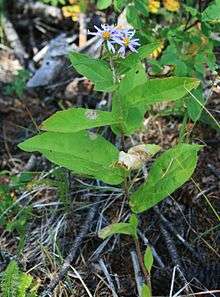Eurybia conspicua
Eurybia conspicua, commonly known as the western showy aster,[3] is a North American species of plants in the composite family. It is native to western Canada (from Manitoba to British Columbia) and the western United States (northern Cascades, northern Rockies, Black Hills, and other mountains of Washington, Oregon, Idaho, Montana, Wyoming, and South Dakota).[3][4]
| Western showy aster | |
|---|---|
 | |
| Eurybia conspicua | |
| Scientific classification | |
| Kingdom: | Plantae |
| Clade: | Tracheophytes |
| Clade: | Angiosperms |
| Clade: | Eudicots |
| Clade: | Asterids |
| Order: | Asterales |
| Family: | Asteraceae |
| Genus: | Eurybia |
| Species: | E. conspicua |
| Binomial name | |
| Eurybia conspicua | |
| Synonyms[2] | |
| |
Eurybia conspicua is a perennial spreading by means of underground rhizomes, thus forming loose clonal colonies. Each plant can produce a flat-topped array of 5-50 flower heads, each head with 12–35 blue or violet ray florets surrounding 48–55 yellow disc florets.[3]
References
- "Eurybia conspicua". NatureServe Explorer. NatureServe. Retrieved 2007-06-20.
- "Eurybia conspicua (Lindl.) G.L.Nesom". The Global Compositae Checklist (GCC) – via The Plant List.
- Brouillet, Luc (2006). "Eurybia conspicua". In Flora of North America Editorial Committee (ed.). Flora of North America North of Mexico (FNA). 20. New York and Oxford – via eFloras.org, Missouri Botanical Garden, St. Louis, MO & Harvard University Herbaria, Cambridge, MA.
- "Eurybia conspicua". County-level distribution map from the North American Plant Atlas (NAPA). Biota of North America Program (BONAP). 2014.
This article is issued from Wikipedia. The text is licensed under Creative Commons - Attribution - Sharealike. Additional terms may apply for the media files.
